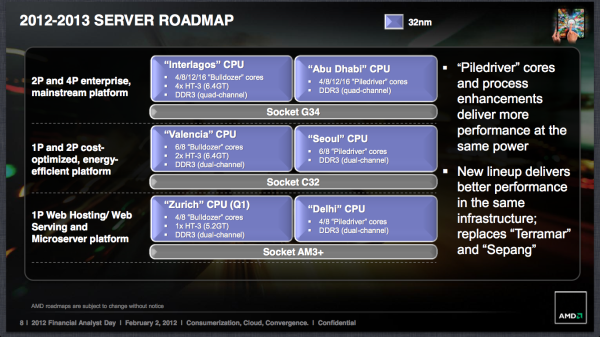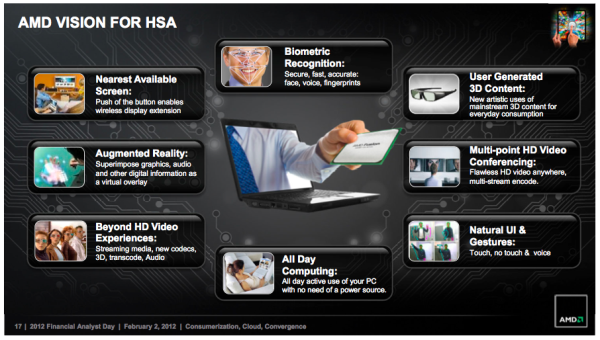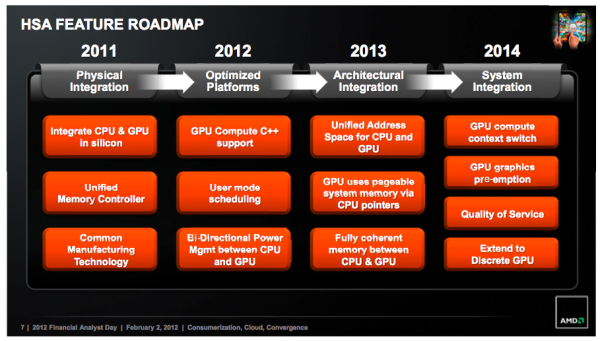Understanding AMD's Roadmap & New Direction
by Anand Lal Shimpi on February 2, 2012 6:16 PM EST- Posted in
- CPUs
- AMD
- Trade Shows
- AMD FAD 2012
The New Focus: Client Mobility
For years we had asked for lower power AMD mobile solutions. While we finally started seeing some progress over the past couple of years, AMD is now very committed to building mobile devices. Anything tablet sized or above is now AMD's target for client APUs.
AMD was always the high-end x86 CPU alternative to Intel in the PC space, now AMD is going to be the alternative in the ultra mobile space.
Servers & the High End Desktop
AMD's server roadmap for the next two years is a bit more conservative. We'll see Piledriver updates from top to bottom but there's no significant departure from the way things are done today. There are no plans for any new sockets in the near term, just using existing platforms to grow AMD's server marketshare without huge new investments.
As AMD's client strategy is predominantly built around APUs, the only high-end desktop parts we'll see from AMD are low-end server CPUs. Socket-AM3+ has a future for one more generation and we'll likely see other single-socket, high-end platforms for the desktop. The days of AMD chasing Intel for the high-end desktop market are done though. That war is officially over.
The Ace: HSA
AMD isn't going to have the fastest general purpose x86 CPUs on the market and it is no longer interested in pursuing that goal. It does promise to have much better on-die GPU performance than Intel. For users today that's primarily an advantage in 3D gaming. As more workloads shift to the GPU however, AMD could have a significant advantage here. The problem is that seamlessly scheduling client workloads across CPUs and GPUs just hasn't happened, the two islands of compute horsepower have remained discrete - even on the new wave of integrated APUs.
AMD's Heterogenous Systems Architecture (HSA) plans to change that. AMD wants to see the creation of a virtual ISA that will be the backbone of a software layer that can schedule application workloads on any combination of underlying CPU/GPU hardware, regardless of the ISA of the hardware. If you have a workload that's best run on big, general purpose x86 cores, that's where it will run. If a task is better designed for highly parallel GPUs cores, it'll run there. And presumably if you had an ARM core somewhere underneath and the workload would run better on it, you'd be covered as well.
AMD plans on delivering an HSA enabled GPU family by 2014, with today's Graphics Core Next GPUs being an intermediary step that already fill a number of these goals. These HSA GPUs would be able to share the same memory space as CPUs and work seamlessly as coprocessors. Granted AMD doesn't have the best track record of quickly moving the industry with things like HSA (although AMD64 did work out quite well), so we'll have to wait and see how all of this plays out.
If AMD can get broad industry support for HSA then its APUs become much more attractive. The overall performance of AMD solutions would then become more compelling as they'd take both CPU and GPU architectures into account, again assuming the workloads require both.













84 Comments
View All Comments
honsonic - Sunday, February 5, 2012 - link
well its just sad this may lead to intel dominating a certain market and controlling the prices, also developing tech in the future won't be hindered by this.polyzp - Monday, February 6, 2012 - link
We will see awesome competition at the 600-800 dollar range from amd. 17w trinity looks like it will be the 17w king. Quadcore with discrete graphics performance in an ultrathin form factor and crazy good battery life. It will be interesting to see if ivy bridge ulv graphics even comes close.http://AMDFX.blogspot.com
Onslaught2k3 - Tuesday, February 7, 2012 - link
AMD has about until late 2014 to turn things around before Intel is able to go fabless. Once Intel goes fabless they have the opportunity to either cut costs or make even more money by contracting fabrication to TSMC or any other semiconductor firm on a cheaper bill. I honestly DO hope AMD does make a comeback with either excavator or piledriver. Bulldozer certainly dozed off for AMD....wumpus - Saturday, April 14, 2012 - link
Highly competitive GPUs (usually win everything between chipset based to ulta-high end)Uncompetitive CPUs (with the rare competitive fusion chips, and others are often worth the good deals you can get at microcenter).
Zero-content marketing giberish. I don't think anyone can compete with AMD's buzzword/sentence, nor have a chance to compete with them on new "long term plans" that mean absolutely nothing.